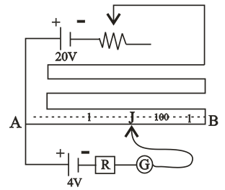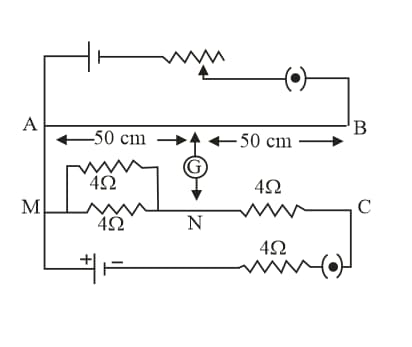Potentiometer Principle - Comparing the Emf of Two Cells
Potentiometer Principle - Comparing the Emf of Two Cells: Overview
This topic covers concepts, such as, Potentiometer, To Find EMF of an Unknown Battery Using Potentiometer, Advantages of Potentiometer Over Voltmeter & Disadvantages of Potentiometer etc.
Important Questions on Potentiometer Principle - Comparing the Emf of Two Cells
Write down five disadvantage of the potentiometer.
What kind of precautions shpuld we take while using potentiometer?
A potentiometer is an accurate and versatile device to make electrical measurements of because the methods involves:
Potentiometer is most sensitive than voltmeter because
The and resistance per unit length of potentiometer wire is . Find the null point length in the given below circuit diagram of a potentiometer.

If the radius of the potentiometer wire is doubled then effect on null point-
The sensitivity of a potentiometer can be increased by_____________________?
Standardisation of potentiometer is done in order that they become-
The length of a wire of potentiometer is and the of its standard cell is . It is employed to measure the of a battery whose internal resistance is . If the balance point is obtained at from the and the of the battery is
Pick out the application of potentiometer from the following.
The balancing length of a potentiometer is at . On shunting the cell with a resistance of , the balancing point shifts to a length of . Then, find the internal resistance of the cell.
A potentiometer wire of length has a resistance of . It is connected in series with a resistance box and a storage cell. If the potential gradient along the wire is . What is the resistance unplugged in the box?
A potentiometer wire of length has a resistance of . It is connected in series with a resistance of and accumulator of having negligible internal resistance. A source of is balanced against a length of the potentiometer wire, what is the value of ?
A potentiometer is basically a Calibrating instrument
Why potentiometer is used in calibration of ammeter ?
A cell of is balanced at . Then what is balanced length for ideal cell of ?
In the following figure, the between the points and is balanced against length of potentiometer wire of total length . In order to balance the potential difference between the points and the jockey to be pressed on potentiometer wire at a distance of :

The potential gradient of potentiometer is . current of is flowing through coil of resistance. The balancing length in meters for the at the ends of this coil will be
The length of a wire of a potentiometer is and the emf of its standard cell is . It is employed to measure the emf of a battery whose internal resistance is . If the balance point is
The potential gradient of a potentiometer wire is defined as
